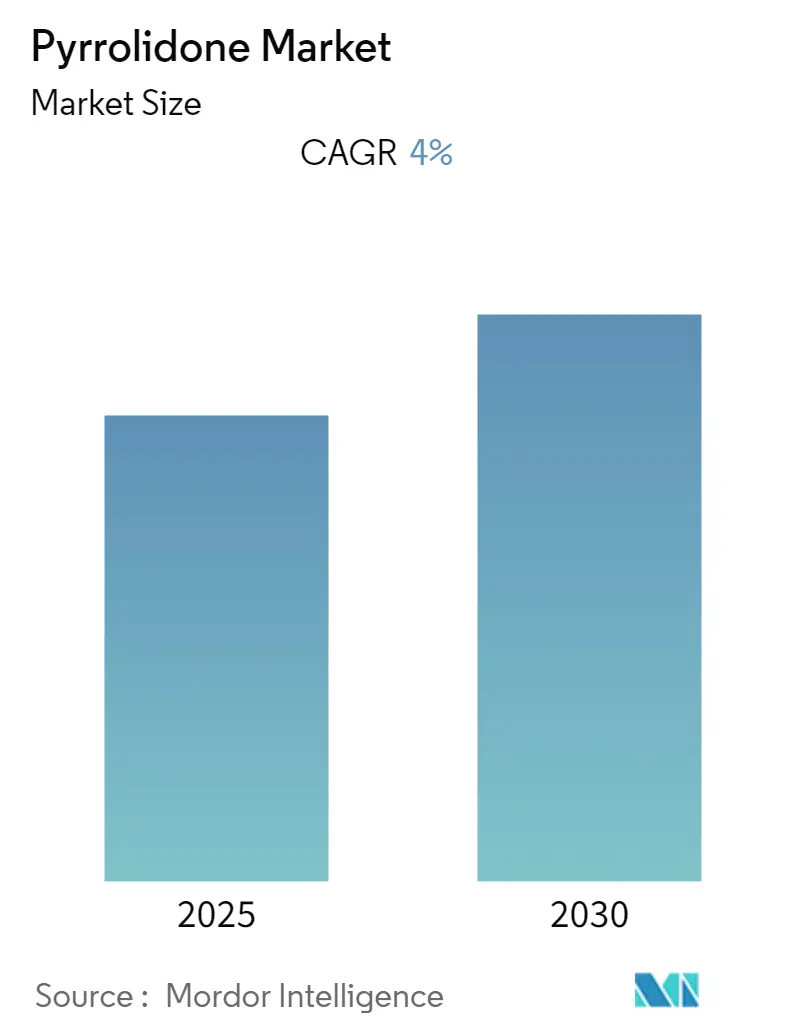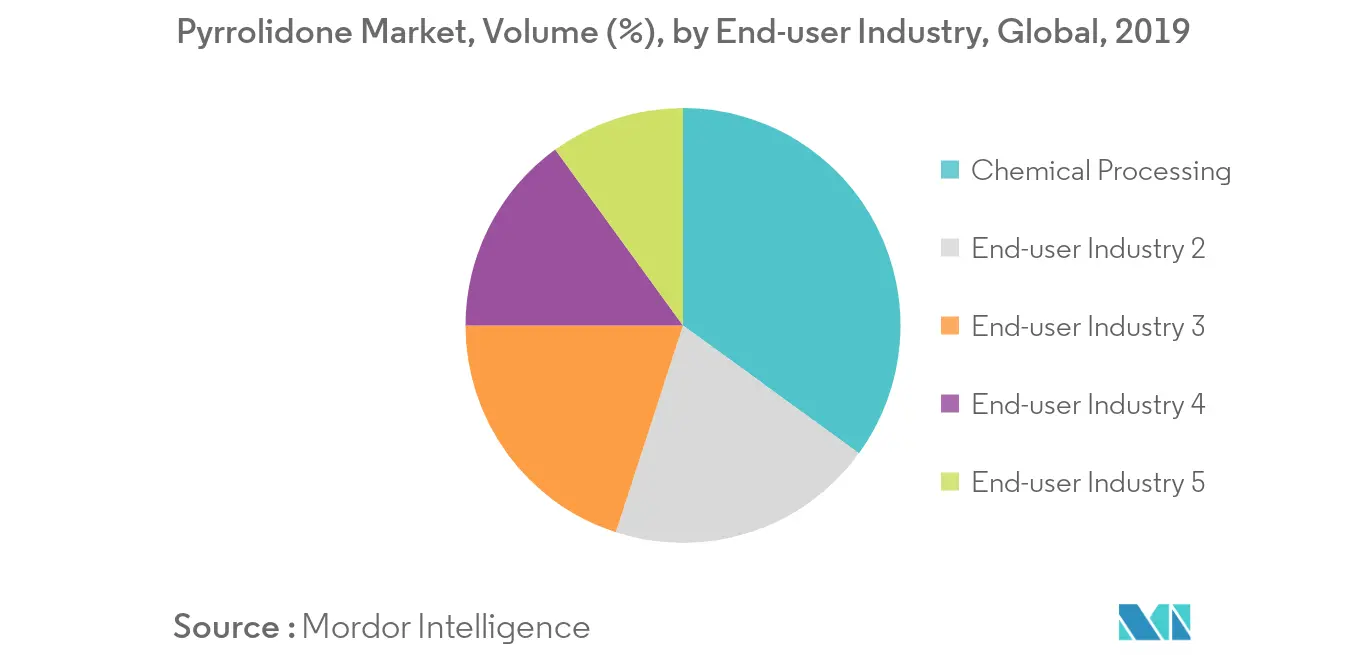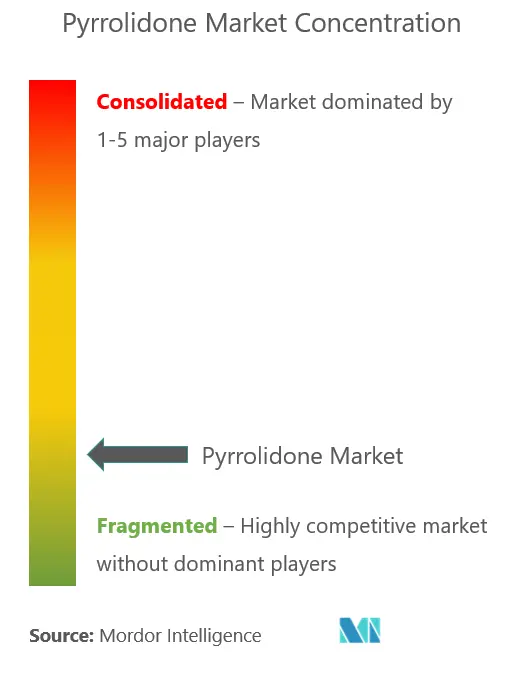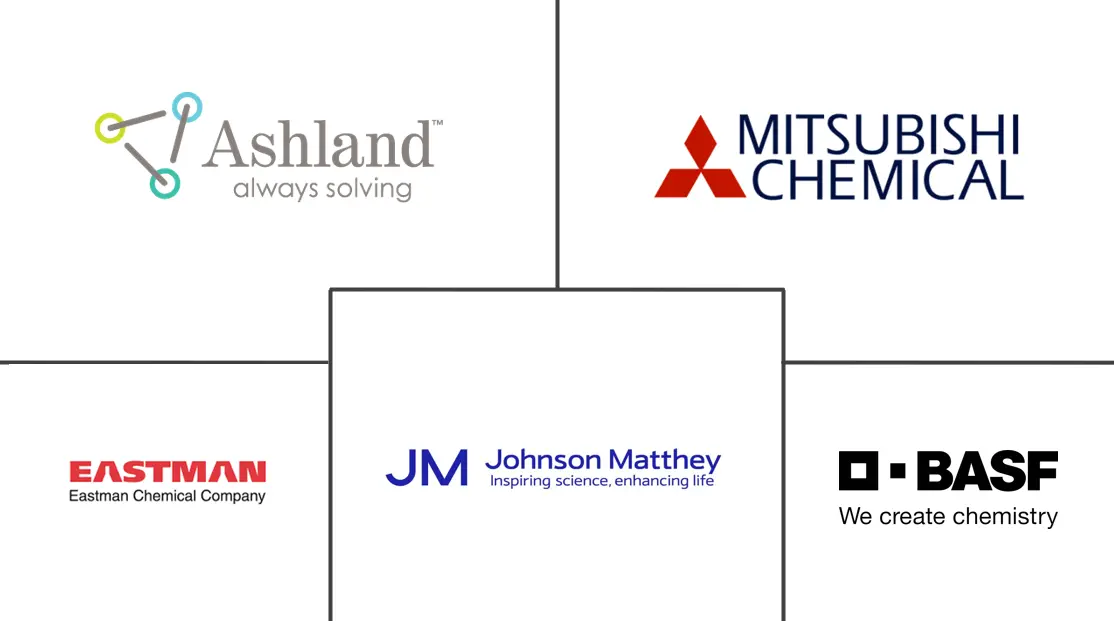Pyrrolidone Market Size and Share

Pyrrolidone Market Analysis by Mordor Intelligence
The Pyrrolidone Market is expected to register a CAGR of 4% during the forecast period.
- The development of 2-Pyrrolidone derivatives as pharmaceutical drugs is expected to offer various opportunities for the growth of the market.
- The chemical processing and cosmetics sectors are likely to be the dominant segments, in terms of demand, over the forecast period.
- Asia-Pacific dominates the market across the world, with the largest consumption from countries, such as China, Japan, South Korea, and India.
Global Pyrrolidone Market Trends and Insights
Increasing Demand from Chemical Processing Industry Segment
- 1-Methyl-2-Pyrrolidone, 2-Pyrrolidone, and N-Methyl-2-Pyrrolidone are intensively used in the chemical processing industry, which is anticipated to register a CAGR of about 5%, globally, during the forecast period.
- Major applications of the pyrrolidone derivates in the chemical processing industry are in extracting agents, reaction solvents, equipment washing, surface coating solvents, de-colorants, and plasticizers.
- Pyrrolidone is heavily used in major unit operations present in refineries and petrochemical plants to extract the various useful chemicals. For example, N-Methyl Pyrrolidone (NMP) is used for the extraction of aromatics from heavier lube distillates for improving the viscosity index. The refining and petrochemicals market is growing at about 4% per year, indicating a stable demand from the sector.
- The chemical processing industry is expected to dominate the pyrrolidone market over the forecast period.

Asia-Pacific to Dominate the Market
- Asia-Pacific is expected to be the dominant market in pyrrolidone consumption, as the region dominates the market for the end-user industries, such as chemical processing, electronics, and cosmetics. In countries, like China, Japan, South Korea, and India, the demand for pyrrolidone has been increasing.
- Pyrrolidone is also used as an ingredient in cosmetic formulations. Japan, Singapore, South Korea, Hong Kong, and China are among the top 10 global cosmetics exporters, and the overall Asian cosmetic market is expected to register a CAGR of about 5% during the forecast period.
- N-Methyl-2-Pyrrolidone also finds application as a photoresist stripper, degreasing agent, and coating polyamides in the electronics industry. The Asian electronics market is expected to register a CAGR of more than 5%, with China, Japan, India, and South Korea among the top 10 global electronics manufacturers.
- Thus, the rising demand from the aforementioned end-user industries is expected to drive the growth in the Asia-Pacific region.

Competitive Landscape
The pyrrolidone market is fragmented with the presence of both international and domestic players. The major companies include BASF SE, Ashland, Eastman Chemical Company, Johnson Matthey, and Mitsubishi Chemical Corporation.
Pyrrolidone Industry Leaders
-
BASF SE
-
Ashland
-
Eastman Chemical Company
-
Johnson Matthey
-
Mitsubishi Chemical Corporation
- *Disclaimer: Major Players sorted in no particular order

Global Pyrrolidone Market Report Scope
The scope of the pyrrolidone market report includes:
| 1-Methyl-2-Pyrrolidone |
| 2-Pyrrolidone |
| N-Methyl-2-Pyrrolidone |
| Other Types |
| Solvent |
| Decolorant |
| Plasticizers |
| Other Applications |
| Electronics |
| Cosmetics |
| Chemical Processing |
| Pharmaceuticals |
| Other End-user Industries |
| Asia-Pacific | China |
| India | |
| Japan | |
| South Korea | |
| Rest of Asia-Pacific | |
| North America | United States |
| Mexico | |
| Canada | |
| Europe | Germany |
| United Kingdom | |
| Italy | |
| France | |
| Rest of Europe | |
| South America | Brazil |
| Argentina | |
| Rest of South America | |
| Middle-East and Africa | Saudi Arabia |
| South Africa | |
| Rest of Middle-East and Africa |
| Type | 1-Methyl-2-Pyrrolidone | |
| 2-Pyrrolidone | ||
| N-Methyl-2-Pyrrolidone | ||
| Other Types | ||
| Application | Solvent | |
| Decolorant | ||
| Plasticizers | ||
| Other Applications | ||
| End-user Industry | Electronics | |
| Cosmetics | ||
| Chemical Processing | ||
| Pharmaceuticals | ||
| Other End-user Industries | ||
| Geography | Asia-Pacific | China |
| India | ||
| Japan | ||
| South Korea | ||
| Rest of Asia-Pacific | ||
| North America | United States | |
| Mexico | ||
| Canada | ||
| Europe | Germany | |
| United Kingdom | ||
| Italy | ||
| France | ||
| Rest of Europe | ||
| South America | Brazil | |
| Argentina | ||
| Rest of South America | ||
| Middle-East and Africa | Saudi Arabia | |
| South Africa | ||
| Rest of Middle-East and Africa | ||
Key Questions Answered in the Report
What is the current Pyrrolidone Market size?
The Pyrrolidone Market is projected to register a CAGR of 4% during the forecast period (2025-2030)
Who are the key players in Pyrrolidone Market?
BASF SE, Ashland, Eastman Chemical Company, Johnson Matthey and Mitsubishi Chemical Corporation are the major companies operating in the Pyrrolidone Market.
Which is the fastest growing region in Pyrrolidone Market?
Asia Pacific is estimated to grow at the highest CAGR over the forecast period (2025-2030).
Which region has the biggest share in Pyrrolidone Market?
In 2025, the Asia Pacific accounts for the largest market share in Pyrrolidone Market.
What years does this Pyrrolidone Market cover?
The report covers the Pyrrolidone Market historical market size for years: 2019, 2020, 2021, 2022, 2023 and 2024. The report also forecasts the Pyrrolidone Market size for years: 2025, 2026, 2027, 2028, 2029 and 2030.
Page last updated on:
Pyrrolidone Market Report
Statistics for the 2025 Pyrrolidone market share, size and revenue growth rate, created by Mordor Intelligence™ Industry Reports. Pyrrolidone analysis includes a market forecast outlook for 2025 to 2030 and historical overview. Get a sample of this industry analysis as a free report PDF download.



